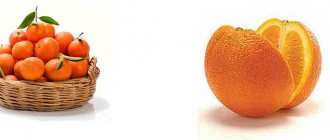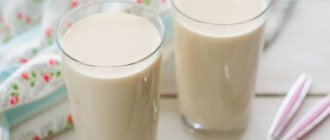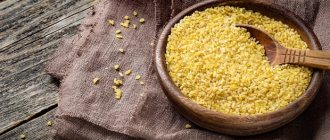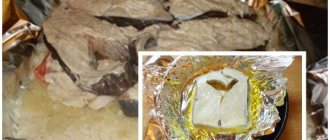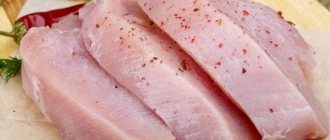Properties of wheat slice
How much does wheat slices cost (average price for 1 pack)?
Moscow and Moscow region.
25 rub.
Taking care of our health, we are increasingly trying to purchase food products that would not only have increased gastronomic qualities, but also, undoubtedly, be beneficial for the body. Today, on store shelves in diet food departments you can find many low-calorie products, which are not only characterized by reduced nutritional value, but also contain little fat and carbohydrates in the form of sugar. It is among such healthy products that wheat slices stand out.
Wheat slices are one of the varieties of natural dietary products made from high-quality raw materials. Wheat slices are produced from whole wheat grains, which necessarily go through the germination stage. During the process of rapid heat treatment under the influence of very high temperatures, the grains explode, forming an airy structure and increasing in volume.
After this, the popped grains can be further enriched with vitamin and mineral supplements, as well as salt or a sweetener. The result is slightly salted or sweetened wheat slices. At the last stage of production, wheat grains are pressed using special equipment and packages with neatly folded round washers end up on store shelves.
You can use wheat slices as an independent dish, eating them with tea or coffee. Some people successfully replace bread with this product. Many people like to make delicious low-calorie sandwiches and sandwiches with vegetables, herbs or spices based on wheat slices. Good desserts and cereals are obtained by adding crushed wheat slices to a variety of liquid products: sour cream, milk, cream, creams, yoghurts, melted chocolate.
Nutritional information | Vitamins | Minerals
How much do Slices cost (average price for 1 pack)?
Slices are a modern natural dietary product that is extremely beneficial for the human body and, in addition, has enhanced gastronomic qualities. Slices are produced by special processing of whole sprouted cereal grains, in which they are first exposed to high temperatures and then pressed.
Today you can buy only slices made on the basis of any one type of cereal, but also multi-component ones. The former include wheat, rice, barley, oat and buckwheat slices, while the latter are represented by wheat-rice, wheat-corn, wheat-buckwheat, wheat-rye, wheat-millet, rice-buckwheat or even tri-cereals (buckwheat, rice and wheat) products.
Slices can become an almost complete replacement for the traditional flour product – bread. When crushed, they can be mixed with heated milk or water to produce a healthy and easy-to-prepare porridge. In addition, slices are great for making diet sandwiches with herbs, vegetables or spices. You can also prepare delicious desserts and other sweet dishes using them.
Which breads are best to eat when losing weight?
Nutritionists note that wheat slices can be used as a dietary product. But this is only a component of the diet, and not a subject for combating excess weight.
Buckwheat slices ideally meet dietary requirements . Even those people who hate buckwheat love them. The product does not contain sugar or yeast and retains all the healing properties of buckwheat. It contains no gluten or potential allergens. Therefore, for those who suffer from a predisposition to allergic reactions, bread can replace pastries.
Buckwheat products are also recommended for anemia, cancer, diabetes, and in case of malfunction:
- thyroid gland;
- gastrointestinal tract (GIT);
- kidney;
- liver.
Rye bread has great nutritional value and quickly nourishes the body . They are rich in microelements and vitamins, which are especially important during the diet. At the same time, such a product contains high-quality, easily digestible protein. Recommended for metabolic disorders and reduced digestion speed. They can be consumed by those who love white bread.
Rice slices are considered the standard of a proper cleansing diet . When eating just one loaf of bread, a person receives less than 40 kcal and almost 80% carbohydrates. If brown grain was used to make the slices, the product is rich in plant fibers. Rice cakes are recommended for diets or during fasting days.
Cornbread is digested slowly by the body, which requires a lot of energy . During the diet, they are carbohydrate nutrition. Not recommended for problems with the gastrointestinal tract and a tendency to obesity. Malt breads have a light and airy structure . Typically contain sesame seeds, malt and sunflower seeds. They are not considered low-calorie, but are acceptable for consumption on a diet.
Bran slices . Rich in carbohydrates and insoluble dietary fiber, low in protein and fat. They do not contain sugars, but contain polysaccharides. The product takes a long time to digest and creates a feeling of satiety even with small consumption. The fiber concentration in the product can reach 40%. Bran bread goes perfectly with the Dukan diet. Whole grain breads are considered the healthiest . Many people who care about their health have long replaced bread with them. Extruded slices from o. will be really useful.
To lose weight, you should choose bread with a high concentration of fiber and low calorie content (up to 300 kcal per 100 g).
The benefits of slices
The benefit of wheat slices lies, first of all, in the fact that no yeast is used in their production, so the finished product, unlike the same bread, can be stored for a much longer time. In addition, compared to traditional bread, slices retain almost all the beneficial properties of the grain. Wheat slices are rich in a whole palette of vitamins (A, PP, E and B) and microelements (potassium, calcium, magnesium, iron and phosphorus).
When consumed regularly, the benefits of wheat slices are manifested in a beneficial effect on many human organs and systems. In particular, the healing effect of consuming this product is due to the content of a large amount of fiber, which, like a sponge, absorbs all harmful compounds in the human body and naturally removes them from the body.
Depending on the composition of the product, the benefits of slices can manifest themselves in a beneficial effect on various organs of the human body. For example, oat slices are useful for people who suffer from kidney ailments, those prone to neurodermatitis and other skin problems, as well as colds. Barley and wheat slices are irreplaceable if you have problems with the gastrointestinal tract, while products made from buckwheat are suitable for diabetics and overweight people. In addition, the benefits of rice slices are relevant for insomnia.
Multigrain slices, made from a mixture of various grains, are useful for almost any person, as they are a valuable source of carbohydrates, protein, vegetable fats, minerals, fiber and vitamins.
With regular use, the benefits of slices are manifested in the removal of cholesterol, radionuclides, heavy metal salts and toxins from the body. In addition, gastrointestinal motility is significantly improved, immunity is increased, weight is normalized, intestinal dysbiosis is eliminated, and the risk of heart and vascular diseases is reduced.
Composition and calorie content of the product
Wheat bread contains only natural ingredients without chemical additives. It contains a lot of fiber, protein, unsaturated and polyunsaturated fats, dietary fiber, and amino acids. The value is reinforced by a high concentration of tocopherol, retinol, niacin, beta-carotene, vitamins B1 and B2.
The product also contains valuable microelements:
- iron;
- potassium;
- calcium;
- magnesium;
- sodium;
- phosphorus.
The nutritional value of 100 g of wheat slices ranges from 370–382 kcal, the glycemic index is 75. The composition of BZHU 100 g of the product looks like this:
- proteins - 11.0–11.2 g;
- fats - 1.8–4.5 g;
- carbohydrates - 72–80.3 g.
Did you know? Bread was first obtained completely by accident more than 7.5 thousand years ago. In ancient Egypt, a mixture of flour and water was prepared for baking flatbread. She was accidentally left in a warm oven overnight. In the morning, a soft, appetizing dough was discovered.
Use in cooking
Dietary bread has found gastronomic application. It is simply consumed with coffee or tea. A variety of sandwiches and snacks are also prepared on its basis, adding herbs, vegetables and cheese. By chopping the slices and diluting them with water or a dairy product, you can get a nutritious porridge. You can also make desserts from the product.
Also find out how millet porridge affects the gastrointestinal tract, strengthens or weakens stool.
Wheat slices are undoubtedly beneficial for the body. Proper use of this product will significantly reduce the total caloric content of the diet and improve the functioning of the digestive system.
How to use it correctly
Experts note that you can eat no more than 5 slices per day. It is this amount that corresponds to the body's need for dietary fiber. To convert all the fiber consumed, the body will spend more than 200 kcal. It is important to combine products correctly.
Butter, sour cream and vegetables go well with the bread. It is not customary to combine the use of slices with:
- fish;
- milk;
- fruits;
- meat.
Slices with vegetables can replace one of the meals - for example, in the morning or for an afternoon snack. It is not recommended to eat the product in the evening. It contains slow carbohydrates and the body will not be able to do all the work.
Advantages and disadvantages
There is not much information about the benefits and harms of slices. More often than not, this product gets positive reviews. But this is not yet a fully explored topic. After all, experiments recently conducted on rats showed disappointing results. Eating extruded products, animals died. Below we will consider the benefits and harms of slices based on their components.
Pros:
- the functioning of the digestive tract improves;
- the risk of cardiovascular diseases is reduced;
- the body is cleansed of toxins, cholesterol and heavy metals;
- improves skin;
- The functioning of the kidneys and liver returns to normal;
- Intestinal dysbiosis resolves.
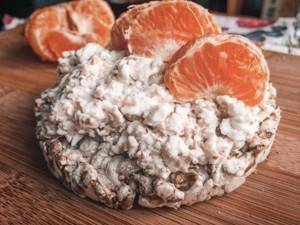
The only disadvantages regarding the benefits and harms of slices include restrictions on consumption and age limits.
Contraindications and harm
Despite a lot of positive qualities, bread can be harmful. If an adult does not feel any negative effects, then it is better not to give them to children under 4 years of age: fiber is not suitable for a child’s body. At an older age, you can give slices for breakfast with cottage cheese products or vegetables.
Important! Before consuming the bread, you should consult a doctor. In some cases, cereal may be contraindicated.
Slices made by baking can cause considerable harm . They have the same calories as white bread and not enough fiber. This means that such products will not be useful for people who are overweight or have problems with the digestive system.
When breastfeeding, experts recommend eating no more than 100 g of bread at breakfast . In this case, the child’s condition should be monitored. If the baby has a negative reaction (bloating, rash, increased gas production), the bread is discarded.
During pregnancy, it is recommended to consume only whole grain slices . In this case, the dose does not exceed 100 g per day so that carbohydrates can be absorbed and bloating and gas formation do not occur.
- There are also a number of restrictions for eating bread:
- Diabetes mellitus type 2 . You can only eat rye, buckwheat or combination products with a low glycemic index. The norm is no more than 3 pieces. per day.
- Diarrhea . Slices can only aggravate the situation, so their use is prohibited.
- Constipation . In case of such a violation, only whole grain breads without yeast and food additives are allowed.
- Colitis or cholecystitis . Slices made from whole grains are allowed. But no more than 100 g per day.
- Mild poisoning . Eating bread is allowed, but only 3 days after the symptoms disappear.
- Pancreatitis . Rye slices of no more than 100 g per day are recommended.
Although the nutritional value of the product is the same as that of bread, it is easily digestible and leaves you feeling full for a long time. Fiber interferes with the absorption of excess calories, so slices can be consumed when dieting. But it should be borne in mind that the norm should be no more than 3–5 pieces per day.
Did you know? Among the Slavic peoples, wheat was a symbol of wealth. Her crops were called “abundance,” which is where the word “abundance” came from over time.

